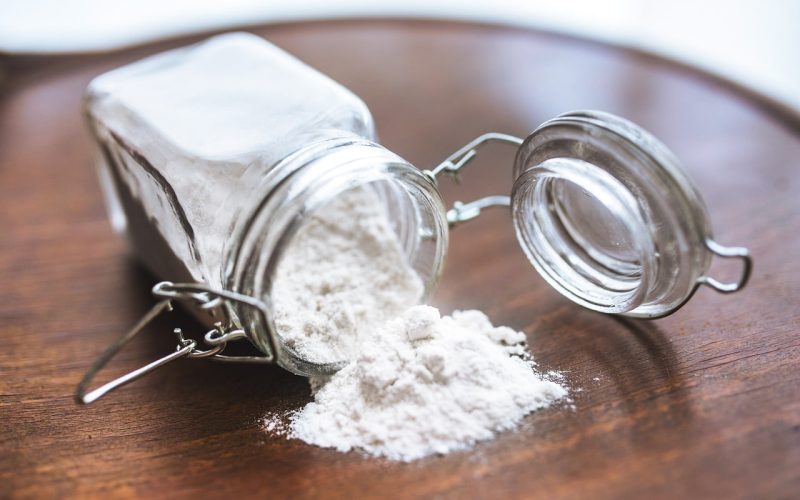Many names, including durum wheat flour, durum flour, and semolina pasta flour, are known as semolina flour.
No matter what you call it, this wheat-based product has become popular due to its high protein and low carbohydrate count.
However, semolina flour can be challenging to come by unless you live in an area where it’s made or imported from Italy or Greece.
Fortunately, plenty of great substitutes for semolina flour are easy to obtain and work in most recipes that call for it.
1. Corn Starch
Cornstarch is an excellent substitute for semolina flour if you want a gluten-free option. It is also a good option if you want to add more fiber to your diet.
Additionally, cornstarch is a good thickener and can be used in baking or as a coating for fried food.
2. Soy Flour
Soy flour is another gluten-free option that can be used as a substitute for semolina flour. It is also a good thickener and can be used in baking or as a coating for fried foods.
3. Potato Starch
Potato starch is another gluten-free option that can be used as a substitute for semolina flour. It is also an excellent thickener and has been shown to have cholesterol-lowering properties!
4. All-purpose Flour
All-purpose flour is a good substitute for semolina flour because it is easy to find and has a similar protein content.
Semolina flour is made from durum wheat, which has a higher protein content than all-purpose flour. This means semolina flour absorbs more liquid and produces a tougher, less elastic dough.
Moreover, all-purpose flour produces a more tender dough that is less likely to crack. When substituting all-purpose flour for semolina flour, you may need to add an extra tablespoon or two of liquid to the recipe.
5. Bread Flour
Semolina flour is a coarse wheat flour with a high protein content.
It is perfect for breadmaking, helping to produce a chewy texture. Plenty of substitutes are available.
However, bread flour is one option that can be used as a substitute for semolina flour.
It has a similar protein content, producing a similar texture in your bread.
Although it doesn’t have the same protein content, it will still make a loaf of bread with a chewy texture.
6. Potatoes
Semolina flour is a type of wheat flour used in many different recipes. It can be hard to find and expensive.
Potatoes are a great option if you’re looking for substitutes for semolina flour.
Moreover, they’re inexpensive and easy to find and will work well in most recipes.
Be sure to use a potato similar in size and shape to the semolina flour you’re substituting.
7. Amaranth Flour
Amaranth flour is an excellent substitute for semolina flour because it is gluten-free, high in fiber and protein, and has a nutty flavor. It is a perfect choice if you’re looking for a health-conscious option.
In addition, It’s a good source of iron, magnesium, potassium, zinc, and copper and provides an excellent alternative to traditional wheat flour. Be sure to look for whole-grain amaranth instead of the more processed variety.
8. Fava Bean Flour
Fava bean flour can be used as an egg substitute or a replacement for regular wheat.
Because of its mild taste, it lends itself well to dishes such as pasta dough. It’s also great when baking because it doesn’t become dry and gritty like other beans.
9. Tapioca Starch
Tapioca starch is an excellent substitute for semolina flour because it has a similar consistency. Plus, it’s gluten-free and works well in recipes requiring much kneading.
Tapioca starch is a great option if you’re looking for an alternative to semolina flour.
10. Oats
Oats are an excellent substitute for semolina flour because they are high in fiber and have a similar texture. Plus, they can be used in a variety of recipes.
Use them as a thickener in soups and stews. Add them to smoothies or shakes for an extra boost of nutrition.
Also, Make oatmeal pancakes or waffles. Cook them into porridge or oatmeal, and mix them into yogurt or cottage cheese.
You can use them as breading for chicken or fish, make oat flour by grinding oats in a blender or food processor, or substitute them for semolina flour.
11. Corn Semolina
Corn semolina is a good option if you’re looking for substitutes for semolina flour.
It’s made from ground corn and has a similar texture to semolina flour.
It’s also gluten-free, so it’s a good choice if you’re looking for a gluten-free option.
You can use it in any recipe for semolina flour, which will work just as well.
12. Garbanzo Flour
Garbanzo flour is an excellent substitute for semolina flour because of its similar texture and color.
Garbanzo flour is also a substitute for semolina flour, which is high in protein and fiber, making it a healthier option. It’s also a good choice if you’re looking for a gluten-free option.
13. Breadcrumbs
Breadcrumbs can be used as a substitute for semolina flour in many recipes. They add a similar texture and can be used in equal proportions.
Additionally, breadcrumbs can help thicken sauces and stews. If you’re looking for a gluten-free option, almond meals or chickpea flour are excellent substitutes for semolina flour.
14. Rice Flour
Semolina flour is made from durum wheat, a wheat with high gluten content.
Gluten gives dough its elasticity, so it’s no surprise that semolina flour is often used in pasta making.
It is consistent with semolina flour and can be used in many of the same dishes.
Notwithstanding, it is a versatile ingredient used in various recipes. It’s perfect for people with gluten sensitivities or celiac disease, as it’s naturally gluten-free.
Plus, it’s a great option if you’re looking for substitutes for semolina flour. Rice flour is also a good thickener and can be used in basking or as a coating for fried foods.
15. Quinoa Flour
Quinoa flour is a nutritious gluten-free option that can replace semolina in most recipes.
This high-protein flour is perfect for anyone with celiac disease or gluten intolerance. It can make pancakes, waffles, muffins, and more.
Furthermore, quinoa flour is a great choice if you’re looking for a nutritious option to add extra protein to your diet.
It is less carbohydrate than wheat flour, making quinoa an excellent substitute for semolina flour. Plus, if you want to reduce the number of carbs per serving without sacrificing flavor or taste.
16. Chickpea Flour
Chickpea flour is another great gluten-free option that can be substituted for semolina flour in most recipes. This high-protein flour is perfect for anyone with celiac disease or gluten intolerance.
17. Pastry Flour
Pastry flour is a good option if you’re looking for light and airy substitutes for semolina flour. It’s made from soft wheat so that it won’t give your baked goods the same chewy texture as semolina flour.
You’ll want to use about half as much when substituting pastry flour for semolina flour. So, if a recipe calls for 1 cup of semolina flour, you’ll only need 1/2 cup of pastry flour.
Pastry flour is also a good choice if you’re looking for a gluten-free option. Just be sure to check the label to make sure the brand you’re buying is certified gluten-free.
18. Whole Wheat Flour
Whole wheat flour can be substituted for semolina flour in most recipes. The texture and flavor of your final product may be slightly different, but the results will still be delicious. When substituting whole wheat flour for semolina, use a 1:1 ratio.
For instance, if the recipe calls for 1 cup of semolina flour, use 1 cup of whole wheat flour instead. Whole wheat flour is a good option if you’re looking for a healthier alternative to semolina flour.
Although it’s packed with nutrients and fiber, it has a lower glycemic index than semolina flour. If you’re concerned about the texture of your final product, don’t be!
19. Rye Flour
Rye flour is a versatile flour with a nutty flavor that can be used in many recipes. It can also be used in place of semolina flour.
When substituting rye flour for semolina flour, use a 1:1 ratio. Rye flour is also a good substitute for semolina flour for those with gluten sensitivities or allergies.
20. High-gluten Flour
When finding a substitute for semolina flour, high-gluten flour is often the best option.
This type of flour is similar to semolina in terms of protein content and gluten development.
We are making it a good choice for recipes that require these qualities.
However, high-gluten flour is not always easy to find. If you can’t find it at your local grocery store, try looking for it online or at a specialty baking store.
21. Almond Flour
Almond flour is a gluten-free option for celiac disease or gluten intolerance. It has a slightly sweet taste and is rich in vitamins and minerals.
When substituting almond flour for semolina flour, use 1/4 cup of almond flour for every 1 cup of semolina flour called for in the recipe.
You may also need to add an extra egg to your recipe to help bind the ingredients together.
On the other hand, almond flour is an excellent substitute for semolina flour in any recipe that requires it to be vegan or dairy-free since almond flour does not contain eggs or dairy products.
22. Mashed Potatoes
Semolina flour is a type of wheat flour that is used in many different recipes. It can be challenging to find in stores, so many people look for substitutes.
Mashed potatoes are great substitutes for semolina flour. They have a similar texture and can be used in many of the same dishes.
Meanwhile, mashed potatoes can be substituted for semolina flour. Use equal mashed potatoes in place of the semolina flour in the recipe. You may need to add extra liquid to the dish, but mashed potatoes will work just as well as semolina flour.
Conclusion
Semolina flour is a type of wheat flour that is commonly used in pasta and bread making. While it can be challenging to find in stores, several substitutes for semolina flour can be used.
We hope this list helps you find the perfect replacement so you can return to your cooking without any worries!
All in all, remember to use these other flours as a substitute for semolina flour. All-purpose flour will produce heavier dough. Cornmeal is best boiled on high heat. It will make sweeter-tasting foods than regular oatmeal, and so on.
Finally, follow recipe directions carefully when substituting one product for another. Too much or too little of certain ingredients can drastically change how your dish tastes and comes out. Happy cooking!








